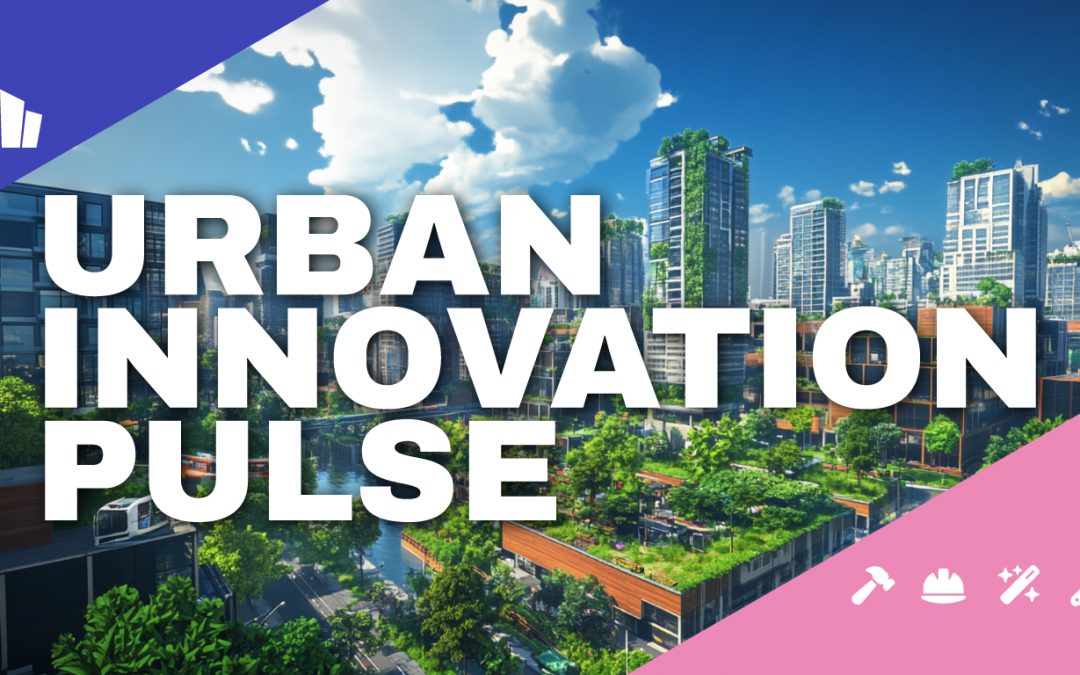Search Date Range: February 10, 2025 – February 17, 2025
This week’s Urban Innovation Pulse highlights key innovations in the built environment from February 10 to February 17, 2025. From AI-driven energy efficiency in smart buildings, to nature-based solutions enhancing urban resilience, advancements in sustainable construction materials, and emerging concepts in urban design, this report explores how technology is shaping the future of our cities and infrastructure.
Smart Buildings
-
AI Enhances Energy Efficiency in Manhattan Skyscraper
In New York City, 45 Broadway has implemented BrainBox AI technology to optimize its HVAC systems. This integration has led to a 15.8% reduction in energy consumption by analyzing real-time data such as temperature, humidity, and occupancy patterns. Time
-
Integration of IoT and AI in Building Management
Buildings are increasingly adopting IoT devices combined with AI to enhance operational efficiency. These technologies enable predictive maintenance, personalized environmental settings, and improved security systems, leading to smarter and more responsive building management. Sensgreen
-
Building Information Modeling (BIM) Revolutionizes Facility Management
Building Information Modeling (BIM) is transforming facility management by providing digital representations of physical and functional characteristics. This technology allows for efficient planning, design, and maintenance of buildings, enhancing overall operational efficiency. ServiceChannel
-
Advanced Security Systems in Smart Buildings
The adoption of AI-enabled surveillance and facial recognition systems is enhancing security in smart buildings. These technologies provide proactive measures by detecting unusual activities and offering secure, keyless entry, thereby improving safety and user convenience. Sensgreen
Smart Cities
-
Nature-Based Solutions Combat Urban Flooding
Cities worldwide are implementing nature-based solutions to address urban flooding exacerbated by climate change. Initiatives include the creation of green roofs, permeable pavements, and artificial wetlands to absorb excess rainfall and improve resilience. Financial Times
-
5G Technology Enhances Public Building Efficiency in the UK
The UK government is exploring the deployment of 5G technology to reduce energy consumption in public buildings. Smart sensors connected via 5G networks can monitor and manage heating and lighting systems, potentially saving taxpayers £580 million annually. The Sun
-
Driverless Buses Begin Trials in Milton Keynes
Milton Keynes, UK, has commenced trials of driverless, pod-like buses designed to improve urban mobility. These autonomous vehicles aim to provide smarter, greener, and more inclusive transportation options for residents. The Sun
-
Integration of IoT in Urban Infrastructure
Cities are increasingly integrating IoT devices into urban infrastructure to enhance efficiency and sustainability. Applications include smart street lighting, waste management systems, and environmental monitoring, contributing to improved quality of urban life. State of Green
Advanced Materials
-
Self-Healing Concrete Extends Infrastructure Lifespan
Researchers are developing self-healing concrete that can autonomously repair cracks, significantly extending the lifespan of structures and reducing maintenance costs. This innovation holds promise for enhancing the durability of infrastructure worldwide. PlanRadar
-
Transparent Wood as a Sustainable Building Material
Transparent wood is emerging as an innovative building material offering sustainability and improved thermal insulation. Developed through the treatment of natural wood, it provides an eco-friendly alternative to traditional glass and plastics in construction. Autodesk
-
Aerogel Insulation Enhances Energy Efficiency
Aerogel, known for its exceptional insulating properties, is being utilized in construction to improve energy efficiency. Its lightweight and porous structure makes it an ideal material for reducing thermal conductivity in buildings. PlanRadar
-
Cross-Laminated Timber (CLT) Gains Traction in Sustainable Construction
Cross-Laminated Timber (CLT) is gaining popularity as a sustainable construction material. Its strength, versatility, and reduced environmental impact make it a favorable alternative to traditional building materials like steel and concrete. Novatr
Emerging Concepts
-
Carbon-Neutral Neighborhoods Pave the Way for Sustainable Living
Bahnstadt in Heidelberg, Germany, exemplifies a carbon-neutral neighborhood where buildings consume significantly less energy. Such developments showcase the potential of sustainable urban planning in reducing carbon footprints. Time
-
AI-Driven Urban Planning Enhances City Design
Urban planners are increasingly utilizing AI to analyze data and optimize city layouts. This approach facilitates efficient land use, improved traffic management, and the creation of livable urban environments. StartUs Insights
-
Superblocks Transform Urban Mobility in Barcelona
Barcelona’s implementation of superblocks—clusters of city blocks restricting through traffic—has transformed urban mobility. This concept prioritizes pedestrians and cyclists, reduces pollution, and enhances community spaces. Maailman Resurssien Instituutti
-
Regenerative Cities Focus on Environmental Enhancement
The concept of regenerative cities is gaining traction, focusing on urban developments that actively enhance local ecosystems. Initiatives include integrating green spaces, promoting biodiversity, and implementing sustainable resource management practices. WIRED
About Urban Innovation Pulse
Urban Innovation Pulse is produced as part of the Future Construction Hub project, coordinated by Metropolia University of Applied Sciences in Finland.
The report synthesizes the latest innovations in four key areas of the built environment:
- Smart Buildings: The latest technologies enhancing energy efficiency, safety, and user comfort.
- Smart Cities: Digital solutions promoting sustainable and efficient urban living.
- Advanced Materials: Cutting-edge materials transforming construction.
- Emerging Concepts: Forward-looking visions for cities and infrastructure.

Report Content and Sources
- Urban Innovation Pulse compiles insights from diverse and credible sources, including:
- Leading research institutions
- Conferences and publications on urban technology
- Innovations from global companies
- Sustainability-focused organizations
This ensures a comprehensive, up-to-date snapshot of trends shaping the built environment. Each highlight comes from a unique, authoritative publication with a valid, clickable link. No source appears more than once within the same category.
To maintain accuracy and credibility, Wikipedia is excluded as a source. We prioritize references to original publications and verified research. Furthermore, the website rakennusalantietotaito.fi is not used as a source to avoid self-referencing.
